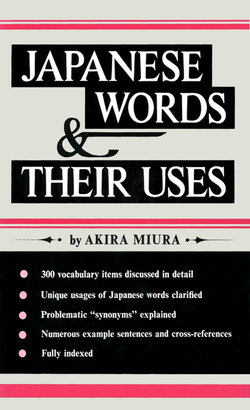Читать книгу Japanese Words & Their Uses II - Akira Miura - Страница 8
На сайте Литреса книга снята с продажи.
ОглавлениеEXPLANATORY NOTES
ARRANGEMENT OF ENTRIES
The main text of this book consists of a list of Japanese terms, alphabetized by their romanized forms, with commentaries. Each entry heading gives the term in romanization, and in Japanese kanji (ideographic characters) and/or kana (syllabics), then one or more English “equivalents.” The kanji usage is kept within the Joyo Kanji, and limited to those widely in use. There follows a detailed explanation of the term’s usage.
TERMINOLOGY
Since this book is meant not as a scholarly treatise but rather as a reference book for elementary- and intermediate-level students, the number of technical terms has been kept to a minimum. The few that are used are by and large from Eleanor Harz Jorden’s Beginning Japanese and/or Matsuo Soga’s and Noriko Matsumoto’s Foundations of Japanese Language.
Adjectives. Japanese adjectives are inflected words that end in -ai, -ii, -ui, or -oi. Hayai “fast,” ookii “large,” furui “old,” and hiroi “wide,” for example, are adjectives. The -ku form of an adjective (e.g., hayaku) is referred to as the adverbial form.
Nouns. Japanese nouns are noninflected words that can occur before desu to constitute complete utterances. Hon “book,” eiga “movie,” and gaijin “foreigner,” are nouns.
Na-nouns. Na-nouns are like nouns in that they may occur with desu to form complete sentences. When a na-noun is used to modify a noun, however, na must be inserted in between (e.g., kirei na hana “a beautiful flower”), whereas a genuine noun takes no instead (e.g., Tookyoo no chizu “a map of Tokyo”). Na-nouns are known by different names in different textbooks, e.g., “nominal adjectives,” “na-adjectives,” and “pseudoadjectives.” Examples of na-nouns are kirei “beautiful,” genki “healthy,” and shitsurei “rude.”
Verbs. Japanese verbs are inflected words that take -masu in the formal nonpast and -mashita in the formal past. Iku “to go,” kuru “to come,” and taberu “to eat,” for example, are verbs.
Stative verbs. Verbs that express states rather than actions are stative verbs. They are such verbs as “to be” and “to have” in English and iru “(someone) is (somewhere)” and aru “(something) is (somewhere)” in Japanese.
Punctual verbs. Verbs representing actions or occurrences that take place without duration over time are punctual verbs. Shinu “to die,” tsuku “to arrive,” and kekkon-suru “to get married” are examples of this type.
Potential forms of verbs. Potential forms are forms that mean “can do such and such” or “such and such can be done.” Yomeru, for example, is the potential form of yomu “to read” and means “can read” or “can be read.”
Particles. Japanese particles are uninflected words that occur within or at the end of a sentence. They generally do not begin an utterance. When they occur within a sentence, they relate what precedes (whether a word, a phrase, or a clause) to what follows. (For this reason, particles are sometimes called “relationals” instead.) Examples of this type are wa, ga, o, and to. Particles that occur at the end of a sentence are called sentence particles, and they make the sentence interrogative, exclamatory, emphatic, etc. Examples of this type are ka, nee, and yo.
JAPANESE ACCENT
Accent marks are used in this book. They are, as a rule, used in the entry headings only, e.g.,.
Unlike English, which has a stress accent, Japanese has a pitch accent. In Japanese words, each syllable is spoken either high or low. If the first syllable is low, the second is always high, and if the first syllable is high, the second is always low. In this book, the mark ┌ indicates a rise in pitch, and the mark ┐ indicates a fall in pitch. The syllable followed by ┐ is always the accented syllable. For example, , a four-syllable word, should be pronounced low–high– high–low, and ki, the last syllable before the fall, is the accented syllable. Some words are left completely unmarked, e.g., kimono. Unmarked words are accentless (or unaccented) words, i.e., words that do not have a fall in pitch. In accentless words, the first syllable is always low, but the remaining syllables are all high, and there is no fall in pitch even when the words are followed by a particle. For example, kimono wa is pronounced
mono wa
ki
Words that end with an accented syllable (e.g., )have the same accent pattern as accentless words when pronounced by themselves, but when they are followed by a particle, a difference emerges. For example, (accented) and kimono (accentless) have exactly the same pitch pattern when pronounced alone, but when followed by a particle (e.g., wa), they are pronounced differently, as follows:
biki
jibiki wa → ji wa
mono wa
kimono wa → ki
Note that wa in jibiki wa is low while wa in kimono wa is high.
ROMANIZATION
The system of romanization used in this book is the popular Hepburn system. There are, however, some points that should be mentioned. In this book, ん is always written n, even before m, p, and b; when n should be pronounced independently of a vowel or y that follows it, an apostrophe is inserted in between, as in hon’ya “bookstore”; long vowels are generally indicated by doubling the vowels (e.g., aa and oo) instead of by using macrons. Long vowels are not indicated in the Bibliography; the honorific prefix o- is not set off.
OTHER CONVENTIONS
An asterisk is used in this book to mark ungrammatical or incorrect utterances. A question mark at the beginning of a sentence indicates unnaturalness or awkwardness. Brackets in Japanese sentences indicate optional portions, while in English translations they show implied meaning.
